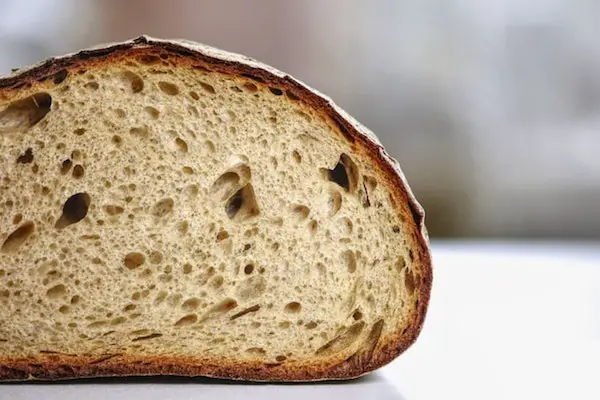Breadmaking is both an art and science. You have to understand the process, as well as the ingredients you are using to make the healthiest and freshest breads possible.

You might not realize that time is a very important factor to consider to avoid rancidity and other problems when milling and baking.
So, let’s talk about freshly milled grains and how it can make a huge difference to your baked items.
Disclaimer: some links used in this post are affiliate links, which means I will earn a small commission if you purchase using my provided links at no extra cost to you. I only recommend products I think will be helpful to you and bring you one step closer to creating tasty bread masterpieces!
What does the milling process look like?
Milling is a process where grains such as wheat, rice, oats, and corn are dehulled and ground into smaller pieces – also known as flours – in order to improve palatability, reduce baking time, and create food products.
What are the benefits of milled grain?

There are 25 vitamins, proteins and minerals, plus high fiber from freshly milled flour of whole grain berries.
Since grain is naturally preserved inside its shell, it’s important to preserve the entire grain until the final moment to get the most nutrients possible. Plus, the whole grain kernel won’t spoil as quickly due to the naturally occurring vegetable oils inside of it.
Freshly milled grain provides a great deal of nutritional benefits – especially when that grain is baked immediately after milling. However, once the grain kernels are milled, flour can get rancid in a short period of time, because of the vegetable oils being released from the kernel.
In fact, studies show that vitamin loss usually happens within 3 hours after milling; this means flours left on the shelf for several months have already lost parts of their C and B-complex vitamins.
So, to make the healthiest and freshest bread possible, you have to mill and bake within 3 hours.
Fresh milled flour vs store-bought flour
Ok, so if you’re panicking a little because you just bought a bag of flour from the store versus milling it yourself, here’s a little breakdown:
Both freshly milled flour and store bought flour will make tasty bread.
So, don’t worry. You didn’t mess anything up.
Store bought flour still comes from milled grain, but it’s just not as fresh (unless you witnessed the miller put the new flour into a bag – highly unlikely lol), and oftentimes doesn’t contain the entire grain. In fact, store-bought flour is usually a mixture of white flour and bran from whole wheat grain.
On the other hand, flour that is freshly milled is nutritionally impactful and just tastes better. A big reason is because the whole grain is used in the milling process, and since you see everything going into the mill, you know exactly what’s inside.
How long is milled grain good for?
Typically, when grain is milled, it has a longer shelf life compared to the store-bought flours. In fact, milled grain typically has a shelf life of 1 year (and sometimes more).
milling flour at home – is it worth it?
If you want to step up your baking game and make bread that tastes fresher, has a longer shelf life and is packed with more nutrients, milling your own flour at home is the way to go.
Plus, if you want to experiment with different types of grains or beans like oat, lentils, buckwheat, quinoa, and barley (just to name a few), a mill can help you turn all of that into flour ready for baking.
And if you want to know what different types of grain can do for your baked goods, read this.
There are lots of different options for milling flour at home – a popular one is using a grain milling machine.
A grain mill machine is a great tool for fresh milled flour because you can set it to different textures like fine or coarse and they work fast, giving you fresh, expertly made flour in minutes.
✅ And if you are not looking to make huge volumes of milled flour, simple countertop mills are a popular choice amongst bakers, our favorite being this Harvest Grain Mill from Nutrimill.

Where to buy grain for home milling?
If you’re looking to buy grains for home milling, you can usually find them at many full-service grocery stores, local health food stores or online stores like Amazon.
✅ Our favorite source for grains are Bob’s Red Mill products, which offers lots of great options (like kamut, spelt, oats, and more), all of which include the whole berry grains. If you can find bags for under $25, it’s a great deal! 👉 Check the price on Amazon
What types of grains can you mill?
There are many grain options you can use to mill and make into flour, even some that exceed this list here. But some of the more common grains include the following:
Durum Wheat
Durum wheat contains high levels of protein, which creates a lemon yellow mealy flour when milled referred to as Semolina, such as the one used for making pasta.
Kamut
Kamut is a high-gluten grain contains high levels of protein and can help bread rise. Kamut grain typically are used for yeasted bread and can also be used to make pasta.
Oats
Oats are not just for oatmeal and cereal. They can make a great flour when milled and provided you get uncontaminated oats, you can add gluten-free (or very little gluten) options when baking.
Wheat Flour
Out of all the grain types, wheat has the highest amount of gluten. When wheat is milled into a flour and made into bread dough, it’ll have better elasticity as you knead it. This in turn helps trap carbon dioxide from the fermenting yeast, giving your bread lots of rise and good-looking texture.
Hard Wheat
Hard white spring wheat, referred to as Prairie Gold and Golden 86 can also be used to make bread, thanks to its high levels of protein. This grain is a hybrid, wherein the bitter compounds of the bran are bred out. This creates a lighter and sweeter grain, making it an ideal ingredient in making pizza dough and French bread. Hard wheat is typically used for yeasted bread.
Soft wheat
Soft white winter wheat is referred to as pastry wheat and is used for cookies, pies, pastries, biscuits, muffins and cakes.
One grain is not like the other
So, why talk about all these grain types? Can’t we just use any one of these when following a bread baking recipe?

Well, yes and no.
See, depending on the bread flour you choose, your resulting baked item will differ in taste and texture.
For example:
- Mixing in 10% to 20% of rice flour results to crunchier cookies.
- Mixing soft white wheat and red wheat 2:3 leads to soft yeasted rolls.
- Mixing oat flour and soft wheat 1:3 leads to cake flour ideal for a very delicate chiffon cake.
Other flours like grains or beans can be substituted for wheat flour in bread recipes, in turn, presenting its own special features.
Grain flours like spelt and kamut don’t contain enough gluten to successfully raise yeast bread. So to help with this, add 1/6 cup of wheat flour to the mix to get high rising breads.
There are so many different grain combinations to explore, all of which can give you amazing baked results that are both tasty and aesthetically pleasing.

